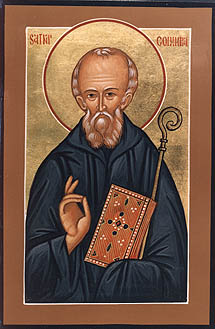St. Columba of Iona


St. Columba of Iona
Our venerable and God-bearing Father Columba of Iona, Enlightener of Scotland (December 7, 521 – June 9, 597) (also known as Columcille, meaning “Dove of the Church”) was an Irish missionary who helped re-introduce Christianity to Scotland and the north of England.
He was born to Fedhlimidh and Eithne of the Ui Neill clan in Gartan, near Lough Gartan, Donegal. On his father’s side, he was the great-great-grandson of Niall of the Nine Hostages, an Irish king of the fourth century. He became a monk and soon rose in the church hierarchy to the rank of priest.

St. Columba’s Bay, where the saint first landed on Iona
He traveled to Scotland, where it is reputed he first landed at the southern tip of the Kintyre peninsula, near Southend. However, being still in sight of his native land he moved further north up the west coast of Scotland. In 563 he founded a monastery on the island of Iona off the west coast of Scotland which became the centre of his evangelizing mission to Scotland. Columban and his monks proclaimed the Gospel to many and founded numerous churches. They sailed to various islands and even went inland in their labors to bring people to Christ. There are many stories of miracles which he performed during his mission to convert the Picts.
Columba is also the source of the first known reference to the Loch Ness Monster. According to the story, in 565 he came across a group of Picts who were burying a man killed by the monster and brought the man back to life. In another version, he is said to have saved the man while the man was being attacked, driving away the monster with the sign of the cross.
St. Columba’s feast day is June 9, and with St. Patrick of Ireland (March 17) and St. Brigid of Kildaire (February 1) is one of the three patron saints of Ireland. The three are buried together in Downpatrick in County Down, deep within the famous Hill of Down.






